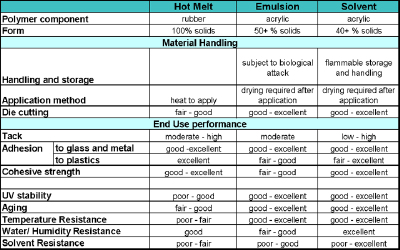Sticking With It | PSAs for Labeling Applications
- Published: July 12, 2016, By Ingrid Brase
How to select the right adhesive for your label to ensure you get it right the first time.
 In previous articles, I have introduced some basics of pressure-sensitive adhesives and a checklist of factors to take into consideration when designing a new product using PSAs. This column will focus on labels.
In previous articles, I have introduced some basics of pressure-sensitive adhesives and a checklist of factors to take into consideration when designing a new product using PSAs. This column will focus on labels.
Today’s labels serve many important functions: they provide information related to the product and are a valuable marketing tool for brand managers. However, the label cannot convey this information if it does not adhere well to the container or product.
PSA labels comprise three main components: the facestock, liner, and adhesive. Facestocks, the ultimate label, vary by use and include paper and film materials. Liners protect the adhesive on the reverse side of the label and allow for easy dispensing. The final component, adhesive, must stick to the surfaces, or substrate, where the label needs to adhere. Linerless labels, where a release coating is applied over the label eliminating the liner, are also available.
So now let’s follow the checklist from the previous column and walk through various factors that must be taken into consideration when designing a pressure-sensitive label.
MANUFACTURING
The selection of the correct adhesive chemistry to use is very dependent on available coating equipment as well as end-use performance targets. The reference table below summarizes the differences between the adhesive forms. As previously described, the coating capability of existing machinery will be a key factor in adhesive selection. Here we will focus more on the end-use performance of the label.
It should be noted that adhesive manufacturers are constantly striving to improve shortcomings of the various adhesive types so these properties should be used as general guidelines. For instance, in recent years clear, UV-stable hot melts have been offered as well as acrylic emulsions that are more water-resistant.

MATERIALS
The second category of concern is to consider the label stock and liner. Label stock selection from various types of paper to film will be the first challenge for good adhesion. The adhesive must have enough affinity for the label stock to hold a strong bond. This is especially critical for removable labels as the good adhesion to the label stock will allow the adhesive to remove cleanly from the surface.
Clear label stock will require a clear adhesive for best visual effect. Both acrylics and hot melts can be used for paper labels whereas some filmic stocks may require only acrylics be used.
Proper selection of liner is also important. For instance, to achieve true clarity in a clear label, use of a filmic liner is recommended as the surface is flat versus the more uneven surface of a paper liner. Understanding how the label will be dispensed will guide the proper liner–adhesive choices.
End Use
Now let’s move to the end use performance needs. The surface or substrate to which the adhesive needs to stick plays a critical role in both selection and coat weight. Uneven, rough surfaces, such as wood, masonry, fabrics, and cardboard, require higher coat weight or thickness of adhesive to create a good bond for the label. The adhesive must be soft enough to flow into crevices but have enough cohesive strength to hold the label in place. Highly curved surfaces, such as a syringe barrel, require higher cohesive strength to hold the facestock in place and prevent wing-up of the label as the facestock tries to revert to being flat.
The cleanliness of the surface also will influence both adhesive type and formulation components. Dust, oil, and moisture all represent challenges to achieving a strong bond of the label to the surface. Smooth, clean surfaces are relatively ease to bond with, thus both acrylic and hot melt adhesives will work well.
Application temperature is the temperature at which the label is applied to the surface. For instance, most meat packing rooms are kept at lower than room temperature so adhesives are specially formulated to maintain good tack and wet out at lower temperatures. Service temperature is the temperature the label sees while in use. A label may be applied at room temperature and be required to maintain bond strength in both hot and cold conditions. Acrylics generally have a broader service temperature range than hot melts. Acrylics are the chemistry of choice for high temperature applications where the hot melts will begin to soften.
Labels need to survive a range of environmental conditions in addition to temperature. These can include humidity, solvents, and UV light to name a few. Solvent acrylics and hot melts will generally be more humidity resistant than emulsion acrylics. Hot melts are subject to degradation by both solvent and UV light, although recently, formulators have been able to improve the UV stability of hot melts allowing for use in clear label applications. The lifecycle of the label is also a key parameter to consider with solvent acrylics having longer lifespans than emulsions and hot melts being the most vulnerable to degradation over time.
Before we move on, it is important to note that regulatory and product brand requirements for a specific end use also can be a significant factor to consider. As examples, FDA regulations for indirect and direct food use will apply to applications like fruit and snack package labels. UL certification may be necessary for machinery labels. Medical applications have a whole set of very specific testing. On the brand and product side, water bottlers may ask for data to assure no components will leach from the label and transmit through the bottle to contaminate and effect the taste of the water. Understanding these end use needs up front saves lots of time in development and selection of the adhesive!
COST
Finally, cost of the adhesive along with the liner and facestock must be determined so profitability of the final label meets company guidelines. All of this background information does take time to compile. However, it does enable you to make more informed decisions regarding initial selection of the adhesive, hopefully narrowing the choices that will need to undergo testing before submitting your label to the end-user. It improves speed to market by getting it right the first time!
Until next time, Stick With It!
About the Author
Ingrid Brase is a technical market strategist recognized for her ability to translate technical needs into business solutions. Her understanding of pressure-sensitive adhesives and their use is complemented by her strengths in strategic marketing, project management, new product development, and key account management. She is available for consulting or contact assignments in these areas. Ingrid’s expertise is a result of more than 20 years of experience in the p-s adhesives business. She was most recently the market segment director for Henkel Corp., rising to that position after various assignments in the p-s business unit. She began her career as a research scientist then progressed to market-focused roles. Ingrid earned her MBA at Rider Univ. and holds a BS in chemistry from SUNY/Oneonta. She has served on the board of directors for TLMI and AIMCAL in addition to chairing technical teams for both trade associations. Ingrid is a well-known speaker and author on topics related to adhesive use. To learn more about Ingrid or contact her, visit www.ingridbrase.com or call her at 609-558-9760.




